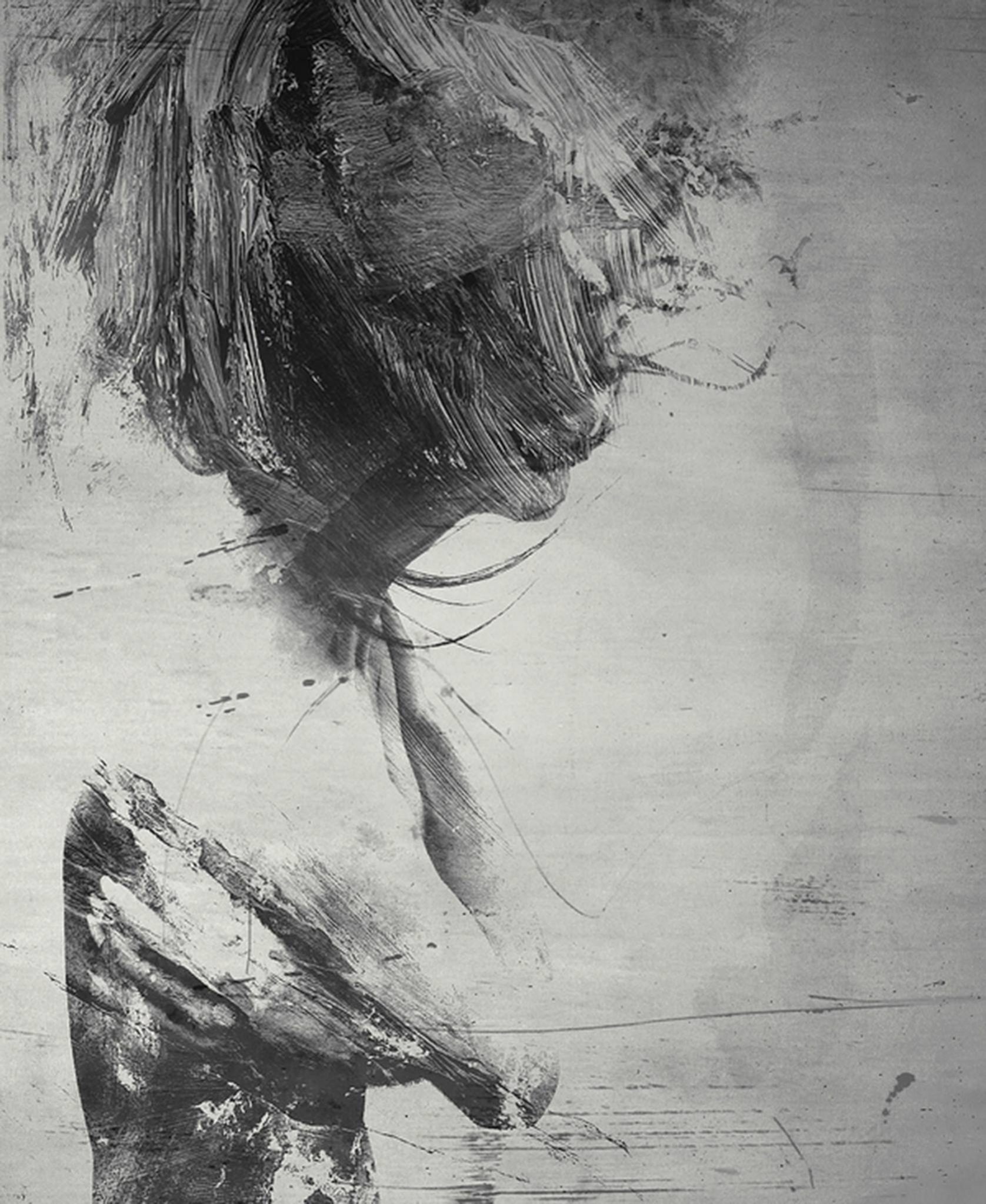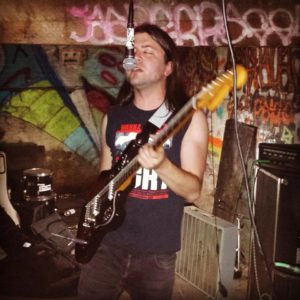“I will tell the audient void…” ZVI + CETACEA + TOPON DAS + MARK MOLNAR @ Black Squirrel Books

Set against the tumult of Arboretum Festival‘s closing night, Ottawa’s underground revealed a single, luring grain of occult temptation at Black Squirrel Books this past Saturday. While the show succeeded in scaring off some unsuspecting stragglers and left a loud impression on some movie-goers across the street at the Mayfair, it delivered a generous dose of dark, industrial metal drone for the intimate audience that collected around each solo performer.
The night’s lineup included experimental cellist Mark Molnar (Ottawa), guitarist Topon Das (Ottawa), vocalist and guitarist Cetacea (Toronto), and guitarist Ron Varod (New York). The arrangement of performance order proved to be stylistically consistent and created room to interpret narrative development over the entire show. And despite the uniform sound shared by all of the musicians that night, the diversity of each of the performer’s individual projects and musical influences would have made the show appealing to fans of a range of metal cult icons: the avant-garde metal compositions of Kayo Dot, the grindcore assault of Fuck the Facts, the lunatic brooding of Sunn O))), and the feral improvisation of Keiji Haino.
MARK MOLNAR
Ottawa-based experimental cellist and mastermind of local label Black Bough Records, Mark Molnar is a regular solo performer at Black Squirrel and was the first musician to take the spotlight. Manipulating the cello’s thick sound through an incomprehensible array of pedals and switches, Molnar delivered a palette of sounds that would blur from emulating peaceful, throaty woodwind to the shrieking demon of a possessed synth. Molnar’s distorted cello reveals a consistent exploration of the physicality of sound: every movement of the bow would resonate through the body and left a very tangible impression.
It is evident when Molnar performs that he does not necessarily work with a single narrative throughout an individual track. This makes sense when considering the influence of free-jazz and improvisation on his other projects, including participating in the Improvising Musicians of Ottawa/Outaouais (IMOO). The compositions instead weave together visual fragments, ideas of scenes which manifest through tone that is heavy with symbol. These subtle images might appear as the shadow of a prayer call from the parapet of a shrine, the rumbling undertow of a black hole, or even a gentle reference to the cello’s classical voice. There is even an abstracted allusion to rhythm in Molnar’s use of repetition and suspension, creating a palpable experience of time.
While Molnar’s cello set was filled with the usual tinges of distorted woodwind and possessed synth that would be familiar to anyone who had seen his previous performances, there was a noticeable difference to the ambiance and progression of his performance on this particular night. This may have been a result of being limited to a single track — Molnar’s sets usually develop with patience over two or three tracks — or for the sake of atmospheric continuity with the other featured performers. Having recently performed at Montréal’s Casa del Popolo as one third of improvisational, jazz-noise intersecting trio, 1/4 tonne overhaul, Molnar may have also been channeling the remnants of a more nihilistic direction embraced by that particular show at Casa del Popolo.
Since Molnar’s tracks can sound different at every performance (his improvisation as well as the potential for the listener to experience the sounds in completely new ways), it was difficult to immediately tell if the track he performed was the usual instrumental with which he would close most solo performances. Regardless, it had a noticeably more aggressive character and development, with a thicker, more metallic sound that served as an appropriate prelude to the rest of the performers.
TOPON DAS
As Topon Das prepared for his set, it was interesting to consider recurring comments on the acoustic space of Black Squirrel Books. An unusual venue for any band, the space posed especially unique challenges for creating the dark ambiance of the night’s performers; these were musicians who rely on atmosphere as an integral part of extending their music and the listener’s experience. In this regard, the bookshop was not effective in creating the tension necessary to fully appreciate the hypnotic and disturbing elements of each musician’s performance. It seemed however, that the opposite effect of intimacy and warmth in the room served an equally important purpose that changed what may have been the intended coldness of everyone’s sets.
First there was a strong contrast between the harsh noise of the instrumentals against the wood and paper of the room — maybe an insignificant detail, but it felt like the space absorbed many layers of sound. Noise from outside — a stray voice or the rumble of a motor — in turn amplified the feeling of seclusion and intensity. In this way, a different aspect of the evening’s show became a point of focus: the introverted quality of each musician’s performance.
Topon Das is known to the Ottawa and Gatineau region as the long-standing guitarist of local grindcore band Fuck the Facts. My first ever legitimate, completely-in-context moshpit was at a Fuck the Facts concert (a proud night), and the subdued character of Topon Das’ performance was completely unexpected. This itself heightened the feeling of anticipation throughout his set. The explosive nature of Topon Das’ repertoire with FTF was overturned into what felt like a voyeuristic invasion of someone’s private moments in composition. Crouching over the blinking switch-boards for almost his entire set, Topon Das would pluck a few notes into his guitar, and then fiddle with the pedals strewn around him. This made for a grotesque contrast between the restraint of his process and the crushing, static-drenched behemoth of industrial drone that came from the haphazard wall of amps behind him.
If there is any way to describe what Topon Das was summoning, it would be the dysmorphic limbs of sound being pulled through a meat-grinder and stretched into and through themselves like an unrelenting Möbius strip. He played with some cyclical structure, his subtle variations evoking the eerie effect of a music-box. The show’s volume became all the more apparent; it was ugly, physically painful, emotionally disturbing. And yet, through this onslaught, he would occasionally reveal the familiar sound of the guitar (unexpectedly sounding for some fleeting seconds like the trill of a flute), which now seemed nostalgic and simple against the crackle of noise. Offering slight comfort just before hitting the midway point of Topon Das’ set, even this identifiable instrumental presence was soon overtaken by a sonic beast that rumbled, snarled and growled like a military helicopter.
BRYAN W. BRAY // CETACEA
The introverted quality of process that became especially apparent during Topon Das’ set was aptly picked up by Toronto-based guitarist Bryan W. Bray, who performs as Cetacea. With a moniker that refers to the mammal order of whales, dolphins, and porpoises, including the great blue whale, Cetacea’s performance seemed to draw a subtle but present analogy to the quiet sorrow of intelligence and the anguish of defiance.
Cetacea introduced his narrative with a montage of reverberating, hymnal vocals. For a few minutes, he sat facing the audience in what was until that point, the only direct address to the audience. It was impossible to break attention in this confessional position. After the torrent of dehumanizing, machine-controlled noise, to hear the human voice again felt almost sacred. It was as though the entire show had been destroying every sense of familiar sound, dissociating the ear and the mind from understanding what was occurring.
Again, that semblance of simplicity felt oddly appropriate. Having been socialized to think of melodic composition as intricate, it was humbling to experience the complete reverse, where the anarchic nature of noise made its complexity all the more apparent. The faint “normalcy” of Molnar’s cello, Topon Das’ guitar and Cetacea’s voice felt almost comical against an encompassing sound that could not really be explained, let alone entirely controlled.
But again, the peace that was momentarily created by Cetacea’s vocalizing was overwhelmed by a disturbing, certain tide. The static would come sure as a gravity, pulsing low and ominous. Escalating the narrative that had been started through his vocalization, Cetacea switched to his guitar. The textures he scraped out of the strings were shaped by animosity, a spite against the deity that had just been evoked by the choral voice. The anxiety of dark noise returned, preparing the audience for the culminating act.
RON VAROD // ZVI
(Image courtesy of Ron Varod // Somewhere on along the Canadian tour, but not at Black Squirrel.)
New York based multi-instrumentalist Ron Varod is a recent addition to the ever-changing roster of musicians that have passed through Brooklyn’s avant-garde metal band, Kayo Dot. First appearing on the band’s most recently released album Hubardo, Varod will also be appearing on the upcoming album Coffins on Io. It was this association with the constantly reincarnating, experimenting, challenging band that enticed me to see this concert, and which provided some narrative parallels for interpreting ZVI.
In a conclusive manner, Varod revisited every sonic and bodily element of the previous sets. There was of course, some superficial similarity in the grinding, fragmented noise that would again overwhelm the human voice and instrumental musicality, yet the emotional unraveling throughout Zvi was characteristically unique. The brief melody that peered through a haze of static built up a deceptively calm introduction. As Varod crumbled through fatalistic and increasingly distorted riffs, it was clear that the audience was once again being removed from the comforts of recognizable composition. Here, however, there was no assurance of return.
The term “anti-music” was uttered by someone in a break between sets, and now returned in full context as Varod was determined to break all musical structure. It was the final heaving attempt of logic against chaos. For some moments, there was the kind of beauty that could be attributed to structure, to clearly identified notes and progression. Varod finally erupted, a beast wailing against the order, a creature angered and betrayed by the divinity raised by Cetacea. The amps screamed so that the audience was visibly uncertain how far the sense of hearing can be exhausted. Varod’s rage erupted as the primal human cry, shattering through the mic that swung from a metal hook below the ceiling… and yet, his voice was lost in the sonic explosion.
Beyond just being physically painful to experience the concert, the jarring emotional element has only just become possible to fully process. It was almost necessary to become separated from the experience in order to grasp the more delicate undertones of the musicians’ collective performance. Varod’s voice disappearing against the power of an unbearable, wild and inhuman noise amplifies the anxiety and the urgency of his music. Without the pain and confusion of listening to something that cannot ever make complete sense, without experiencing the real effects of decaying sound on the body, without seeing someone ripping their being out of a guttural scream for affirmation only to be consumed into an intolerably loud silence, it would be impossible to see the faint beauty in creating despite the imminence of absurdity.

